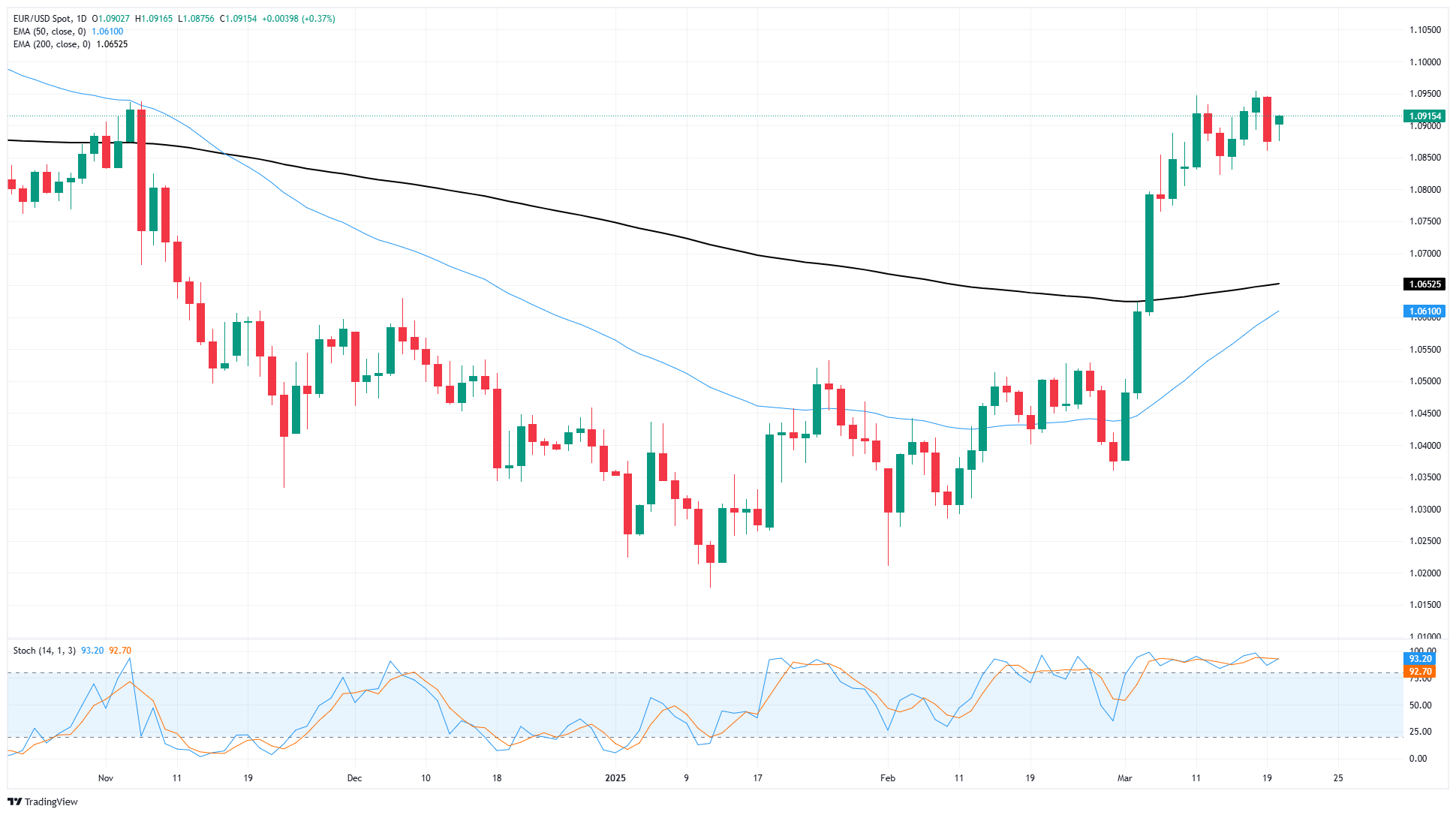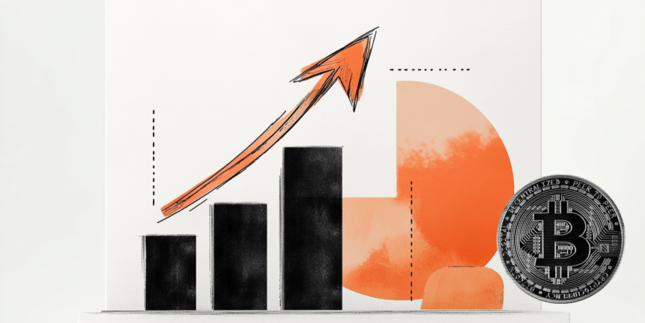- EUR/USD remains hobbled on the south side of 1.1000.
- The Fed held interest rate steady, as investors expected.
- Despite downside risks to growth and inflation, Fed still sees rate cuts in 2025.
EUR/USD remained bolstered above the 1.0900 handle on Wednesday, propped up by a general easing in Greenback flows after the Federal Reserve (Fed) met markets in the middle and held rates steady for another meeting. Fed Chair Jerome Powell noted that growth projections for 2025 have been significantly hindered by the Trump administration's erratic policy of announcing trade tariffs on social media only to later retract them. As a result, the Federal Open Market Committee (FOMC) revised its end-2025 Gross Domestic Product (GDP) forecast to 1.7%, a sharp decline from the 2.1% estimate shared in December.
Fed's Powell: We are not going to be in any hurry to move on rate cuts
Additionally, the median dot plot suggests that the end-2025 interest rate will remain at 3.9%, indicating little change since the last policy meeting. The FOMC plans to begin slowing down its balance sheet runoff starting in April. Rate markets continue to signal a greater than 50% chance of a quarter-point rate cut in June, with most rate traders assigning a 65% probability of a quarter-point or larger cut on June 18.
Despite rising risks to the US economy from lagging growth metrics and increasing concerns that the US's erratic tariff policy could trigger both new inflation and an economic recession simultaneously, Fed Chair Jerome Powell stated on Wednesday that the current economic outlook remains generally healthy, and the Fed is not in a hurry to alter its expectations of at least two more rate cuts later in the year.
European Central Bank (ECB) President Christine Lagarde will be making an appearance on Thursday, and the latest round of the EU’s Leadership Summit also kicks off. ECB talking points are highly unlikely to produce nearly as many sparks as the Fed’s outing on Wednesday, so Fiber impacts are set to remain muted.
EUR/USD price forecast
From a technical viewpoint, the Stochastic Oscillator is currently in overbought territory above 80.00, though it is showing signs of flattening, indicating a reduction in bullish momentum. Meanwhile, the Moving Average Convergence Divergence (MACD) displays flat green bars, suggesting a lack of strong trend conviction. Collectively, these indicators imply that the pair may enter a consolidation phase prior to making a definitive move.
Looking ahead, resistance is positioned at the 1.1000 level, which has historically served as a significant barrier. On the downside, initial support can be found around 1.0850, with more substantial support near the 20-day moving average close to 1.0800. A decline below these thresholds could trigger a corrective reaction, while consistent trading above 1.0900 would maintain the overall bullish outlook.
EUR/USD daily chart
Euro FAQs
The Euro is the currency for the 19 European Union countries that belong to the Eurozone. It is the second most heavily traded currency in the world behind the US Dollar. In 2022, it accounted for 31% of all foreign exchange transactions, with an average daily turnover of over $2.2 trillion a day. EUR/USD is the most heavily traded currency pair in the world, accounting for an estimated 30% off all transactions, followed by EUR/JPY (4%), EUR/GBP (3%) and EUR/AUD (2%).
The European Central Bank (ECB) in Frankfurt, Germany, is the reserve bank for the Eurozone. The ECB sets interest rates and manages monetary policy. The ECB’s primary mandate is to maintain price stability, which means either controlling inflation or stimulating growth. Its primary tool is the raising or lowering of interest rates. Relatively high interest rates – or the expectation of higher rates – will usually benefit the Euro and vice versa. The ECB Governing Council makes monetary policy decisions at meetings held eight times a year. Decisions are made by heads of the Eurozone national banks and six permanent members, including the President of the ECB, Christine Lagarde.
Eurozone inflation data, measured by the Harmonized Index of Consumer Prices (HICP), is an important econometric for the Euro. If inflation rises more than expected, especially if above the ECB’s 2% target, it obliges the ECB to raise interest rates to bring it back under control. Relatively high interest rates compared to its counterparts will usually benefit the Euro, as it makes the region more attractive as a place for global investors to park their money.
Data releases gauge the health of the economy and can impact on the Euro. Indicators such as GDP, Manufacturing and Services PMIs, employment, and consumer sentiment surveys can all influence the direction of the single currency. A strong economy is good for the Euro. Not only does it attract more foreign investment but it may encourage the ECB to put up interest rates, which will directly strengthen the Euro. Otherwise, if economic data is weak, the Euro is likely to fall. Economic data for the four largest economies in the euro area (Germany, France, Italy and Spain) are especially significant, as they account for 75% of the Eurozone’s economy.
Another significant data release for the Euro is the Trade Balance. This indicator measures the difference between what a country earns from its exports and what it spends on imports over a given period. If a country produces highly sought after exports then its currency will gain in value purely from the extra demand created from foreign buyers seeking to purchase these goods. Therefore, a positive net Trade Balance strengthens a currency and vice versa for a negative balance.
BRANDED CONTENT
If you're looking for the best brokers to trade the EUR/USD pair, explore our selected options. Knowing each broker’s strengths will help you find the ideal fit for your trading strategy.
Information on these pages contains forward-looking statements that involve risks and uncertainties. Markets and instruments profiled on this page are for informational purposes only and should not in any way come across as a recommendation to buy or sell in these assets. You should do your own thorough research before making any investment decisions. FXStreet does not in any way guarantee that this information is free from mistakes, errors, or material misstatements. It also does not guarantee that this information is of a timely nature. Investing in Open Markets involves a great deal of risk, including the loss of all or a portion of your investment, as well as emotional distress. All risks, losses and costs associated with investing, including total loss of principal, are your responsibility. The views and opinions expressed in this article are those of the authors and do not necessarily reflect the official policy or position of FXStreet nor its advertisers. The author will not be held responsible for information that is found at the end of links posted on this page.
If not otherwise explicitly mentioned in the body of the article, at the time of writing, the author has no position in any stock mentioned in this article and no business relationship with any company mentioned. The author has not received compensation for writing this article, other than from FXStreet.
FXStreet and the author do not provide personalized recommendations. The author makes no representations as to the accuracy, completeness, or suitability of this information. FXStreet and the author will not be liable for any errors, omissions or any losses, injuries or damages arising from this information and its display or use. Errors and omissions excepted.
The author and FXStreet are not registered investment advisors and nothing in this article is intended to be investment advice.
Recommended content
Editors’ Picks

Gold surges to fresh record high above $3,400
Gold extends its uptrend and trades at a new all-time high above $3,400 on Monday. Concerns over a further escalation in the US-China trade war and the Fed’s independence smash the US Dollar to three-year troughs, fuelling XAU/USD's rally.

EUR/USD clings to strong gains near 1.1500 on persistent USD weakness
EUR/USD gains more than 1% on the day and trades at its highest level since November 2021 near 1.1500. The relentless US Dollar selling helps the pair push higher as fears over a US economic recession and the Federal Reserve’s autonomy grow.

GBP/USD tests 1.3400 as USD selloff continues
GBP/USD continues its winning streak, testing 1.3400 on Monday. The extended US Dollar weakness, amid US-Sino trade war-led recession fears and heightened threat to the Fed's independence, underpin the pair following the long weekend.

How to make sense of crypto recovery – Is it a buy or fakeout
Bitcoin (BTC), Ethereum (ETH) and XRP, the top three cryptocurrencies by market capitalization, extend their last week’s recovery on Monday, even as trader sentiment is hurt by the US President Donald Trump’s tariff policy and announcements.

Five fundamentals for the week: Traders confront the trade war, important surveys, key Fed speech Premium
Will the US strike a trade deal with Japan? That would be positive progress. However, recent developments are not that positive, and there's only one certainty: headlines will dominate markets. Fresh US economic data is also of interest.

The Best brokers to trade EUR/USD
SPONSORED Discover the top brokers for trading EUR/USD in 2025. Our list features brokers with competitive spreads, fast execution, and powerful platforms. Whether you're a beginner or an expert, find the right partner to navigate the dynamic Forex market.



